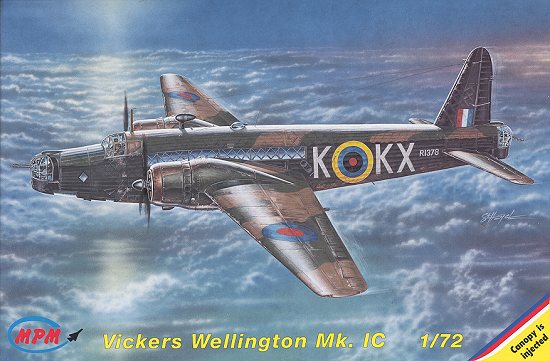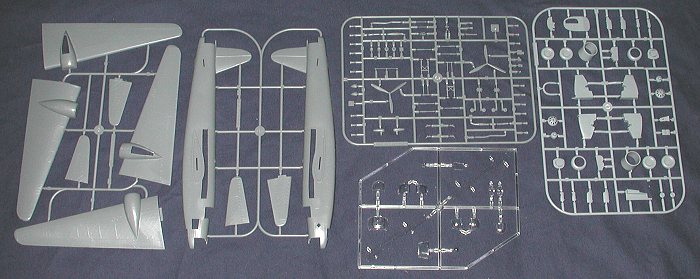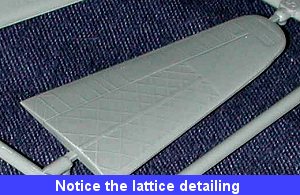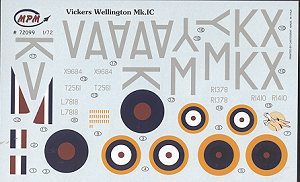
|
KIT: |
MPM 1/72 Wellington IC |
|
KIT # |
72099 |
|
PRICE: |
$ |
|
DECALS: |
five aircraft |
|
REVIEWER: |
|
|
NOTES: |

|
HISTORY |
You could arguably state that the Wellington was the finest of Britain's early war bombers. It certainly was used a great deal and built in considerable numbers. Designed in the mid 1930's by Barnes Wallis (who also designed the 'spinning bomb' of Dambusters fame), the Wellington's unusual lattice construction made for an aircraft that was structurally extremely strong. Hundreds of bomber crews thanked that strength when their severely damaged Wellingtons were able to limp back home or at least stay in the air long enough for them to escape.
The IC version of the Wellington differed from its earlier companions by having Frazier Nash turrets fore and aft and no upper fuselage turret. Those guns being replaced by beam guns. This allowed for slightly greater speed. It was further enhanced by twin 1,000 hp Bristol Pegasus XVIII radial engines. This hardly made it speedy with a maximum speed of 255 mph, but every bit helped. Maximum bomb load was 6,000 pounds, but that was for only relatively short ranges.
Despite its growing obsolescence, the Wellington was kept in production for most of the war. When bombing in Europe was turned over to the heavier Sterlings and Lancasters, the role of the Wellington switched to Coastal Command operations where enemy opposition was much lighter. In those areas where enemy action wasn't as heavy, such as North Africa and the Middle East, the aircraft continued to be an effective bomber. Eventually over 11,000 units were produced and many survived the war in secondary duties such as training and weather reconnaissance.
|
THE KIT |

With this and similar new mold kits, MPM has managed to shake the 'short run'
out of its kits. How can one tell? For me, some of the tell-tale signs
are; an injected canopy and clear parts, no photo etched bits, and no resin.
When the mold making process has improved to where it is no longer needed to
rely on resin for high detail, then one can easily see that the company has made
it.  In addition I see that
the sprues have the sprue and part numbers on them. This is also the first time
I've seen alignment pins on an MPM kit.
In addition I see that
the sprues have the sprue and part numbers on them. This is also the first time
I've seen alignment pins on an MPM kit.
Starting with the clear bits, they are superbly molded with no stress marks. Some may say they are a bit thick, but I don't see that as a problem. Clarity is quite good, though there is some distortion due to the thickness. Detailing of the rest of the kit is excellent. As you might expect, it is engraved panel lines and in this case, you can see the lattice work on the wings and tail surfaces (see image of one of the horizontal stabs). There is also very good representation of the fabric covered fuselage. Never having seen a Wellington long enough to examine it, I'm not sure about how pronounced the lattice representation should be so, but it looks properly subdued to me.
There is full lattice detail on the inside of the fuselage, though it is marred in places by ejector pin marks that will be difficult to fill. Frankly, though, few will be concerned about this as it will be pretty well hidden once the fuselage is together. The kit interior shows the beam gun positions, though there are no clear bits for them nor is it open for them.
Cockpit detail and turret detail is quite good for this scale as is the detail in the wheel wells. The only part of this kit I'm not looking forward to is assembling the engines. MPM gives you a central core onto which you glue all the cylinders. Personally, I'd rather have the engine in one piece, thank you. A very nice change is that the prop is a complete assembly. No need to glue separate blades onto a hub! Thank you, MPM!!
 As good as previous MPM
instruction sheets have been, this one is even better. The construction steps
are clearer and more information is given in terms of painting and alignment.
Both Humbrol and FS numbers are given for paints. The decal sheet provides
markings for five different aircraft. All of them are in Dark Earth and Dark
Brown uppers with black under surfaces and fuselage/fin sides. Three aircraft
are from 311 (Czech) Sq in late 1940. Only difference in these are the code
letters. From 37 Sq in Egypt comes the fourth aircraft. Wellingtons had little
in the way of nose art, but this plane has a small one. Finally is a 75 (New
Zealand) Sq Wellington in which Sgt. J. Ward won his Victoria Cross in July
1941.
As good as previous MPM
instruction sheets have been, this one is even better. The construction steps
are clearer and more information is given in terms of painting and alignment.
Both Humbrol and FS numbers are given for paints. The decal sheet provides
markings for five different aircraft. All of them are in Dark Earth and Dark
Brown uppers with black under surfaces and fuselage/fin sides. Three aircraft
are from 311 (Czech) Sq in late 1940. Only difference in these are the code
letters. From 37 Sq in Egypt comes the fourth aircraft. Wellingtons had little
in the way of nose art, but this plane has a small one. Finally is a 75 (New
Zealand) Sq Wellington in which Sgt. J. Ward won his Victoria Cross in July
1941.
|
CONCLUSIONS |
I must say that I'm quite impressed with this kit. This is one kit that has immediately gone on the work bench! You can toss your Airfix Wellington into the collectors pile or give it to a young'un to work on. It seems as if MPM has reached a level that makes building their kits more of a pleasure than ever before. I'm quite pleased to see them reach this level of quality and look forward to more and even better kits from them.
Review kit courtesy of
 . Thank you for your support.
. Thank you for your support.
If you would like your product reviewed fairly and quickly where it will be seen by well over 150,000 visitors a month, please contact me or see other details in the Note to Contributors.